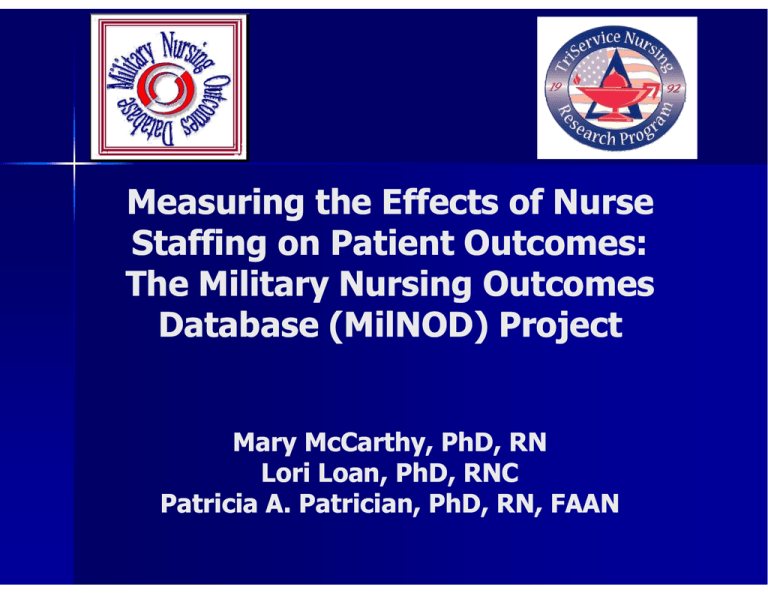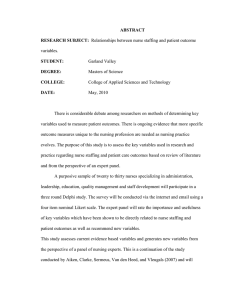Measuring the Effects of Nurse Staffing on Patient Outcomes:
advertisement

Measuring the Effects of Nurse Staffing on Patient Outcomes: The e Military a y Nursing u s g Outcomes Ou co es Database (MilNOD (MilNOD)) Project Mary McCarthy, McCarthy PhD, PhD RN Lori Loan, PhD, RNC Patricia A. Patrician, PhD, RN, FAAN Funding Acknowledgement & Disclaimer This project was funded by the TriService Nursing Research Program, Uniformed Services University of the Health Sciences S i (G (Grantt #N03#N03-P07). P07) However the information or content and conclusions do not However, necessarily represent the official position or policy of, nor should any official endorsement be inferred by, the TriService Nursing Research Program Program, Uniformed Services University of the Health Sciences, the Department of Defense, or the U.S. Government. MilNOD Team Principal Investigators Patricia A. Patrician,, RN,, PhD,, FAAN Lori A. Loan, PhD, RNC Laura R. Brosch, RN, PhD Mary McCarthy, RN, PhD Associate Investigators: Army, Navy, Air Force Consultants – Nancy Donaldson, RN, PhD, FAAN, UCSF, CalNOC – Diane Di Brown, B RN RN, PhD PhD, K Kaiser i Permanente, P CalNOC C lNOC – Bonnie Jennings, RN, DNSc, DNSc, FAAN N me o s RAs Numerous RAs, Database Manage Manager, Database Programmer, P og amme Report Writer, Statisticians R Research hQ Questions i 1. Does staffing affect adverse events at the shift level? 2. Over time, has there been a change in adverse events in MilNOD facilities? Background Institute of Medicine (IOM) Report (1996): •Little empirical evidence that nurse staffing affects p patient outcomes IOM Quality Series (20002004): •Illuminated the critical role of nurses in patient safety Background American Nurses Association (1995). Report Card for Acute Care Settings Collaborative Alliance for Nursing Outcomes (CALNOC) Began to identify id if patient i outcomes that may be linked to nursing care, “nursing-sensitive indicators” of care quality. • 250 hospitals currently yp participate p • Standardized data definitions and ll ti methods th d collection 6 Background A growing national trend towards standardized measurement of nurse staffing and patient outcome indicators Limited standardized nurse staffing and nurse--sensitive patient outcome reporting nurse mechanisms h i iin use iin D Department t t off Defense ((DoD DoD)) hospitals Difficult to compare staffing adequacy or to compare outcomes among DoD hospitals MilNOD Purposes Collect data to support evidence based clinical and administrative decisions. decisions Create a valid and reliable database consisting i ti off nurse staffing t ffi and d patient ti t safety f t indicators. Provide a basis for internal and external comparisons. p Analyze relationships between staffing and outcomes. outcomes MilNOD Indicators Nursing Structural Indicators – RN,, LPN,, NA – Active Duty, GS Civilian, Reservist, Contract N i care hours Nursing h Nursing skill mix Nursing staff education & experience Explanatory Variables – Patient P ti t acuity it – Patient turnover Contextual Features – Work environment attributes Nurse Outcomes – Job satisfaction – Needlestick injuries Patient Outcomes – – – – Pressure ulcer prevalence Restraint use prevalence F ll and Falls d falls f ll with ith injury i j Nursing medication administration errors – Satisfaction with Care in general Nursing care Pain management Education National Quality Forum National Voluntary Consensus Standards for NursingNursing-Sensitive Care CATEGORY Patientcentered outcome measures MEASURE 1. Death among surg. inpts with treatable serious complications-failure to rescue 2. Pressure ulcer prevalence 3. Falls prevalence** 4 Falls 4. F ll with ith iinjury j 5. Restraint prevalence (vest and limb only) 6. Urinary catheter-associated UTI ICU patients** pts)** ) 7. Central line catheter-assoc. blood stream infection rate ((ICU & NICU p 8. Ventilator-associated pneumonia for ICU and NICU patients** Nursingcentered intervention measure 9. Smoking cessation counseling for acute myocardial infarction** 10. Smoking cessation counseling for heart failure** 11. Smoking cessation counseling for pneumonia** Systemcentered measures 12. Skill mix (RN, LVN/LPN, unlicensed assistive personnel [UAP], and contract) 13. Nursing care hours per patient day (RN, LPN, and UAP) 14. Practice Environment Scale—Nursing Work Index 15. Voluntary turnover ** Al Also an NQF NQF-endorsed d d voluntary l consensus standard d d ffor h hospital i l care. Available through the Military Nursing Outcomes Database (MilNOD) 10 Data Acquisition & Dissemination Nurses enter daily staffing & census data into the unitunit level MilNOD database. Every month trained on-site staff collect fall, medication error & needlestick injury data from incident reports. MilNOD team checks and improves data quality. Once each year patient & staff surveys are conducted by the MilNOD team. On-site trained staff collected pressure ulcer & restraint use prevalence data on a semiannual basis. MilNOD team prepares reports & investigates best practices. Reports are disseminated to hospitals. MilNOD team t works k with ith h hospitals it l to understand & use reports. Hospital H it l lleaders d use d data t tto id identify tif problems & evaluate solutions. Best practices, evidence evidence-based based practice policies, and effective solutions are shared across hospitals. Data Analysis Shift level, nested data: – 115, 000 shifts in 57 units from 13 hospitals (7 large and 6 small) Dichotomous outcome – Shift with any adverse event = 1 – Adverse events = falls, medication errors, needlestick dl i k injuries i j i Separate analysis for critical care, medmedsurg,, stepsurg step-down units Results: Shift Level Covariates by Unit Type Mean values N (#shifts) Med-Surg Step-Down Critical care 57,913 18,039 35,570 51 58 77 % LPN 22 24 14 %U Unlicensed li d 28 19 9 44 36 41 % Civilian 34 39 47 % Contract 19 22 8 % Reservist 3 3 5 Total nursing care hours per patient per shift (NCHPPS) 4.3 5.4 9.4 Patient-to-RN ratio 4.8 3.3 1.5 Skill Mix: % RN Provider Category: % Military Hierarchical Logistic Regression Modeling R Results: lt All Adverse Ad Events E t Predictors Shift Evening shift Night shift RN Skill mix (10% Medical-Surgical OR (95% CS) Step-Down OR (95% CS) Critical Care OR (95% CS) 1.01 (0.89-1.15) (0.89 1.15) 0.75 (0.65-0.85) 1.07 (1.00-1.16) 0.83 (0.65-1.04) (0.65 1.04) 0.76 (0.57-0.97) 1.07 (0.98-1.19) 0.93 (0.71-1.20) (0.71 1.20) 0.51 (0.37-0.68) 1.10 (0.95-1.30) 1.04 1 04 (0 (0.97-1.13) 97 1 13) 1.42 (1.10-1.79) 1.04 (0.97-1.13) 1.08 (1.03-1.14) 1.06 1 06 (0 (0.96-1.19) 96 1 19) 1.29 (0.99-1.61) 1.04 (0.93-1.18) 1.01 (0.97-1.07) 1.06 1 06 (0 (0.95-1.18) 95 1 18) 1.45 (1.00-2.03) 1.05 (0.93-1.18) 1.05 (1.01-1.09) 1.13 ((1.04-1.23)) 1.03 ((0.84-1.25)) 1.01 ((0.80-1.25)) 1.13 (1.08-1.18) 1.27 (1.13-1.44) 1.09 (1.01-1.18) d decrease) ) Provider category (10% decrease) % Military % Civilian % Contract Total NCHPPS (1 hour decrease) Average g Acuity y ((1 SD increase) Census ( by 3) R Results lt Summary S • • • Adverse events were lower on night shifts Higher occurrences of adverse events on a shift were associated with lower RN skill mix mix, lower proportion of civilians, decreased total nursing care hours hours, higher acuity acuity, and higher census Civilian proportion may be a proxy for experience: mean difference between military and civilian experience levels was -9.39 (t = -17.88, p <.001) Di Discussion/Implications i /I li ti •Poorly staffed shifts are likely to have bad outcomes t Every shift must be staffed appropriately with attention to not only numbers of staff (nursing presence) but also skill mix (expertise) and presence), experience level • Acuity, although an imperfect measure of workload, is an important consideration for staffing, especially on medicalmedical-surgical units • Question Q i #2 Over time, has there been a change in adverse events in MilNOD facilities? 17 Patient Outcomes Significantly Improved Patient Fall Rates by 69% (p = 0.028) .33 Bed Days 33 per 100 B dD .10 per 100 Bed Days (n=47 Units) (n=45 Units) (n=36 Units) (n=34 Units) (n=30 Units) (n=25 Units) (n=25 Units) (n=24 Units) (n=23 Units) (n-23 Units) 18 Patient Outcomes Significantly Improved Nurse Administered Medication Error Rates by 50% (p = 0.019) .57 per 100 Bed Days .26 per 100 Bed Days (n=47 Units) (n=45 Units) (n=36 Units) (n=34 Units) (n=30 Units) (n=25 Units) (n=25 Units) (n=24 Units) (n=23 Units) (n-23 Units) 19 Li it ti Limitations Use of adverse event reports – UnderUnder-reporting of medication errors? – Falls with injury are typically reported because of additional dditi l care requirements i t Did not control for falls risk in this analysis Did not control for medication doses dispensed Cannot assume cause and effect C Conclusions l i The MilNOD is an efficient, replicable, and sustainable t i bl measurementt strategy t t for f inpatient i ti t care units. Evidence--based management requires data for Evidence decision making: – Local data to determine baseline – National data for comparisons – Evidence from literature to make changes and establish benchmarks – Local continual monitoring of progress towards goals Questions? Q ti ? 22



